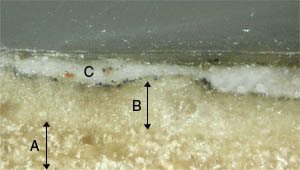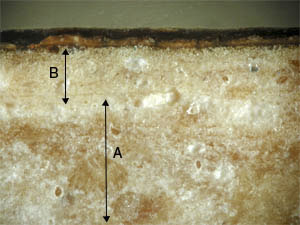
Layers of an ancient panel painting. A: preparatory layer - Coarse “gesso” (a mixture of gypsum and animal glue); B: preparatory layer - Fine “gesso” (a mixture of gypsum and animal glue); C: priming layer.

Layers of “gesso” on an ancient panel painting. A: coarse “gesso” (a mixture of gypsum and animal glue); B: fine “gesso” (a mixture of gypsum and animal glue)
Tempera painting on panels was a popular painting method that was already in use in Medieval times. The panel, preferably in poppy wood, was prepared by applying several layers of carefully polished chalk before being coated with glue.
The colors, consisting of both organic and inorganic pigments, were 'tempered' with egg yolks or whites before being carefully applied to small sections of the finely polished surface with a brush. The painted surface that resulted was dense and elastic. To produce particular effects, the artist would often ‘gloss' the paint surface with thin layers of transparent pigment that reflected light in proportion to the number and density of the layers applied. This technique was called ‘glazing.' Last of all, the painter applied a layer of varnish to make the painting more compact and protect the external agents. In some cases, especially in devotional paintings, gold leafing would be added to highlight certain symbolic details and ornamental elements. This precious material began to fall into disuse in the mid-fourteenth century. Tempera painting was used for altar pieces, small devotional pictures for private residences, portraits, trunks and other furniture. This medium peaked in popularity in the 14th and 15th centuries before gradually giving way, in Italy towards the end of the 15th century and the beginning of the 16th, to paintings that used oil as the medium.
Oil painting, in which the pigment is suspended in oil instead of egg, gradually became the preferred artistic method beginning at the end of the 15th century, and it was used by all subsequent painters until the mid- 20th century.
The origin of this new technique seems to have been Flanders: in the 15th century, highly esteemed paintings by Flemish masters (Jan van Eick, Rogier van der Weyden, Hugo van der Goes) were acknowledged, admired and collected in Italy, too. A few Italian painters had already experimented with this technique, but in the early phases they failed to identify the proper mixture.
And while oil painting was sometimes executed on wood panels, canvases soon became the support of preference whose surface texture could vary from very finely grained to larger and grainier. The types of oils also changed over time, with linen seed oil eventually became the most commonly used. The advantages of oil as compared to tempera is that the first dries much more slowly, enabling the painter to make modifications and changes as he works. As for the support, the use of the canvas instead of wood panels made it easier to preserve and use the paintings. This was especially true for the larger ones, which could easily be rolled for shipping.
In Italy, both oil and tempera methods were used simultaneously - there was no abrupt abandonment of tempera, even though oil became the primary medium and remained the only effective method for creating mobile paintings, and frescoes continued to be used for pictures on walls.
Serena Nocentini